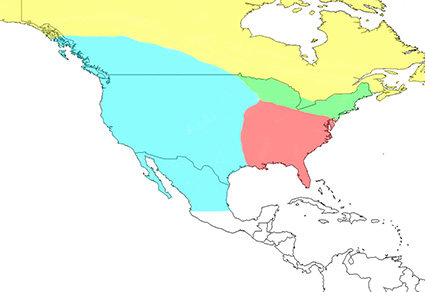Abstract
Based on the geographic distribution database of the Orthoptera Species File, the diversity and distribution of the superfamily Grylloidea in the Nearctic region was studied using the statistics and Sorensen dissimilarity coefficient. A total of 164 species or subspecies belonging to 4 families, 9 subfamilies and 27 genera were recorded from this region; among which Gryllidae (93, 56.70%), followed by Trigonidiidae (44, 26.83%), Mogoplistidae (25, 15.24%), and Phalangopsidae (2, 1.22%). The diversity exhibits an asymmetric distribution pattern, with the southeastern coastal plain, the Interior Plateau and Piedmont of the United States was the most abundant. At the same time, the regional similarity of species distribution was analyzed, and the Nearctic was divided into four subregions: Boreal & Arctic zone of North America, Eastern temperate North America, Northeast temperate North America, and Southern North America & western temperate North America.
References
Cigliano, M.M., Braun, H., Eades, D.C. & Otte, D. (2020) Orthoptera Species File. Version 5.0/5.0. Available from: http://or_thoptera.speciesfile.org (accessed December 2020)
Cox, C.B. & Moore, P.D. (2005) Biogeography: an ecological and evolutionary approach. 7th Edition. Blackwell Publishing, Oxford, 428 pp.
Currie, D.J. (1991) Energy and large-scale patterns of animal and plant-species richness. American Naturalist, 137 (1), 27–49. https://doi.org/10.1086/285144
Holt, B.G., Lessard, J.-P., Borregaard, M.K., Fritz, S. A., Araújo, M.B., Dimitrov D., Fabre, P.-H., Graham, C.H., Graves G.R., Jønsson, K.A., Nogués-Bravo, D., Wang, Z.H., Whittaker, R.J., Fjeldså, J. & Rahbek, C. (2013) An update of Wallace’s zoogeographic regions of the world. Science, 339, 74–78. https://doi.org/10.1126/science.1228282
Holger, K. & Walter, J. (2010) A framework for delineating biogeographical regions based on species distributions. Journal of Biogeography, 37, 2029–2053. https://doi.org/10.1111/j.1365-2699.2010.02375.x
Ingrisch, S. & Rentz, D.C.F. (2009) Orthoptera: Grasshoppers, Locusts, Katydids, Crickets. In: Encyclopedia of Insects. 2nd Edition. Academic Press, Waltham, pp. 732–743. https://doi.org/10.1016/B978-0-12-374144-8.00196-X
Rosenzweig, M.L. (1995) Species Diversity in Space and Time (Review). Environments, 123, 112–113. https://doi.org/10.1017/CBO9780511623387
Tuomisto, H. (2010) A diversity of beta diversities: straightening up a concept gone awry. Part 1. Defining beta diversity as a function of alpha and gamma diversity. Ecography, 33, 2–22. https://doi.org/10.1111/j.1600-0587.2009.05880.x
Wallace, A.R. (1876) The Geographical Distribution of Animals. Cambridge University Press, Cambridge, 503 pp.
Wiken, E., Nava, F.J. & Griffith, G. (2011) North American Terrestrial Ecoregions-Level III. Commission for Environmental Cooperation, Montreal, 149 pp.


